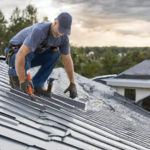Fire safety cannot be overemphasized in home management. Taking all necessary measures to prevent fire hazards in the house will help reduce the risk of fire and possibly endanger the lives of one’s family members. Finally, some step-by-step procedures will help you fireproof your home. This being the case, we have everything in one package, from fixing smoke detectors to developing an emergency evacuation strategy.
Install Smoke Detectors
Smoke alarms goes a long way in preventing and also mitigating the effects of fire in your home. These devices can help you to know that there is smoke and enable you get out of the house. Make sure to:
● Smoke detectors must be on the shopping list, with at least one on every level of the house, in the basement, and in the attic.
● Place smoke detectors inside and outside each bedroom.
● The smoke detectors should be tested monthly while the batteries should be changed at least once a year.
● Replace smoke detectors every 10 years.
Use Fire-Resistant Building Materials
Some ideas that may be very effective include using fire-resistant material when constructing or renovating your home. These can help prevent the fire from spreading around the areas involved in a fire outbreak. Some fire-resistant materials include:
● Gypsum boards: This material is commonly known as drywall. It is normally used in the construction of walls and ceilings and is fire-resistant.
● Concrete is another fire-resistant material because it does not burn or melt when exposed to heat.
● Fire doors: These doors cannot allow fire to pass through them and may also effectively split the house, thus containing the fire.
Maintain Electrical Systems
Sadly, electrical mishaps rank among the primary reasons home fires occur. To reduce risk exposure, the following measures should be taken regarding electrical systems:
● You should also hire a professional electrician to check your wiring and electrical panels occasionally.
● It improves the flow of electrical commodities and hinders charging devices on electrical outlets and power strips.
● Torn cords or plugs should be replaced at once to avoid short-circuiting of the electrical appliances.
● It is also advised that homeowners and businesses use surge protectors, which reduces the high risks of electrical fires caused by power surges.
Safe Use of Heating Devices
Heating devices, such as space heaters and fireplaces, can pose a fire hazard if misused. Follow these safety tips to prevent heating-related fires:
● Keep flammable materials at least three feet away from heating devices. ● Never leave space heaters or fireplaces unattended.
● Install a sturdy screen before your fireplace to prevent embers from escaping. ● Have your chimney cleaned and inspected annually by a professional.
Create a Fire Escape Plan
In the event of a fire, having a well-thought-out escape plan can save lives. Make sure your family knows what to do and where to go:
● Draw a floor plan of your home and mark at least two exits from each room. ● Establish a designated meeting spot outside the home.
● Practice your fire escape plan regularly with all family members.
● Teach children how to escape independently and avoid hiding during a fire. Use Fire Escape Ladders
Having fire escape ladders is crucial, especially for multi-story homes. These ladders provide a safe and quick exit in a fire emergency. Here’s what you need to know:
● Choose the Right Ladder: Ensure you have the correct ladder for your home’s layout and window heights. A 13- 15-foot ladder is usually enough for two-story homes, while three-story homes may need a 20-25-foot ladder.
● Store Them Properly: Keep fire escape ladders in an easy-to-reach location near the windows. In an emergency, you need to grab them quickly.
● Practice Using Them: Regularly practice deploying and using the ladder with your family. This ensures everyone knows how to use it correctly under stress. ● Read Reviews: Opt for highly rated ladders for their durability, weight capacity, and ease of use. Look for Amazon-recommended fire escape ladders with positive feedback.
Store Flammable Materials Safely
Many household items can be highly flammable. Store these materials safely to reduce the risk of fire:
● Keep flammable liquids, such as gasoline and paint thinners, in approved containers and store them in a well-ventilated area away from heat sources.
● Store firewood, paper, and other combustible materials away from the home. ● Dispose of oily rags properly to prevent spontaneous combustion.
Install Fire Extinguishers
Having fire extinguishers readily available can help you quickly put out small fires before they escalate. Follow these guidelines:
● Place fire extinguishers in key areas
● Ensure all family members know how to use a fire extinguisher.
● Check the pressure gauge on fire extinguishers monthly and replace them if they are damaged or expired.
Conclusion
It is essential to safeguard your home against fire; hence, it needs to be fire-proofed. The fire risk can be significantly minimized by installing smoke detectors, using fire-resistant materials in construction, maintaining electric systems, and maintaining safe heating measures. Another prevention mechanism is to develop a fire escape plan and use fire escape ladders to ensure that inflammable materials are stored safely. Be proactive and prepared to keep your families away from disasters that result from fire outbreaks. Ready to equip your home with the best fire safety tools?
Visit ISOPLLC.COM to explore our top-quality fire safety products and ensure your home’s protection today!







